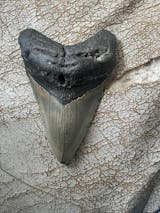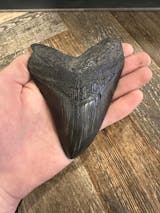🦈 Comparing Megalodon Tooth Sizes: What Does a 2″ vs. 6″ Tooth Tell You?
Megalodon teeth come in all shapes and sizes. From small, juvenile teeth between an inch or two, or in some rare cases, under an inch, to huge, hand-sized giants that can exceed five, six, or even seven inches. To a new collector, that difference might just look like scale. But to seasoned collectors and perhaps some paleontologists, all megalodon teeth, no matter the size, tell an incredible story about the shark’s growth, feeding behavior, and the environment it lived in.
So, What Does a Megalodon's Tooth Size Really Mean?
The size of a Megalodon tooth directly correlates to the size of the shark it came from. Paleontologists estimate that for every inch of the slant height of a tooth (the diagonal distance from the tip of the crown to the corner of the longest root lobe), the Megalodon measured about 10 feet in body length. Of course, some are saying that this isn’t an accurate way to judge a shark’s body length, especially with new research showing that the megalodon shark may have been more like lemon sharks. Longer teeth that don't quite represent its actual body length. Regardless, it’s what scientists have been using for decades, and it's what most collectors still go by to this very day.
But what does this measurement style mean? Let me break it down for you:
- A 2-inch anterior Megalodon tooth likely came from a juvenile measuring around 20 feet long, which is about the size of a modern Great White Shark. Terrifying and cool to think that a small juvenile megalodon shark was the same size as an adult Great White Shark.
- A 4-inch tooth came from a subadult roughly 40 feet long, representing a mid-sized predator still growing into its prime. So, think of a school bus. A subadult megalodon shark would have been roughly the same size as a school bus. Wild, right?
- A 6-inch tooth belonged to a fully grown 60-foot apex predator, one of the largest and most formidable carnivores to ever live. That's about the same size as a six-story building.

The photo above shows the size comparison of a megalodon tooth from a juvenile to a 60-foot apex predator. Photo Credit: Fossil Driven
Megalodon teeth were adapted for powerful shearing and cutting, built to bite through the thick bones of whales and other large marine mammals. Larger teeth not only reflect the shark’s maturity but also how efficiently it could feed. Every megalodon tooth is equipped with sharp serrations. This helped the animal cut through thick blubber and flesh better than any steak knife that you have in your kitchen.

The photo above shows a great example of how sharp megalodon teeth can get. This specimen specifically is from Indonesia. Photo Credit: Fossil Driven
💡 Fossil Driven Fact: The largest verified Megalodon tooth ever found measures 7.48 inches, discovered in Peru, and specimens over 6 inches make up less than 1% of all teeth recovered worldwide. Hence, the hefty price tag that most teeth of this size get. Especially if they are high quality, which are even more rare.
Want to learn more about the megalodon shark? Check out our megalodon shark facts blog!
How Tooth Size Reveals Feeding Habits
Megalodon’s jaws were lined with 276 teeth arranged in five rows, and not every tooth served the same purpose. The position of a tooth in the jaw determined both its shape and size.
Here’s what those differences tell us:

- Anterior (front) teeth – Broad, triangular, and symmetrical. These were the shark’s main cutting tools for slicing through prey.

- Lateral (side) teeth – Narrower and angled, designed for gripping slippery prey.

- Posterior (rear) teeth – Smaller, more curved, and almost compact, used to guide food toward the throat.
So, when you compare a 2-inch megalodon tooth to a 6-incher, the difference might not always mean a smaller shark; it might just come from a different jaw position. That’s why context is everything when identifying and measuring Megalodon teeth. A 3-inch lateral may have been from a 35 to 40-foot megalodon shark. While a tiny posterior like the one above may have been from a juvenile and not a newborn. See what I mean?
📏 Collector Tip: Always measure the slant height, the diagonal distance from the tip of the crown to the corner of the longest root lobe. That’s the industry standard for determining official Megalodon tooth size.

Photo Credit: Fossil Driven
Why Bigger Isn’t Always Better (But It’s Definitely Rarer)
In the world of fossil collecting, size matters, but so do condition, color, and preservation quality. You can talk to a variety of collectors, and each will have a different style in how they like to collect megalodon teeth. Some, like the @sharkodontist on Instagram, may enjoy the smaller juvenile teeth for the purpose of saving space. While others love the giant, pristine teeth due to their rarity. Some may even like worn teeth because they tell a story. There's honestly a tooth for everyone out there.
However, a larger size doesn't always mean a megalodon tooth is worth more than a small juvenile. Other factors, which are discussed more in depth in our How are fossil megalodon teeth priced blog, may push that small juvenile tooth to a higher price than a worn 5-inch megalodon tooth. For example, a perfectly preserved 3.5-inch Bone Valley Megalodon tooth with sharp serrations and rare coloration can easily be worth more than a damaged 5-inch tooth with heavy pitting or restoration.
That said, once you cross the 5-inch mark, scarcity can skyrocket depending on the locality:
- 2–3 inch teeth: Are pretty abundant and ideal for beginner collectors or educational displays. Especially for their price point.
- 3.5–4.5 inch teeth: Mid-range collector pieces that balance size and affordability. You still get a good-sized megalodon tooth without breaking the bank.
- 5–5.75 inch teeth: Sought-after by serious collectors; only a small percentage of teeth reach this size in good to collector-quality condition. Unless you source megalodon teeth from countries like Indonesia. Most that come out of that country are often crazy in size and quality.
- 6 inch+ teeth: Exceptionally rare, often considered “trophy specimens” for bigger collections or museum displays. They are also extremely rare when they are in high or collector-quality condition, hence why megalodon teeth that are this large and higher in quality will run you thousands, if not tens of thousands.
💎 Fossil Driven Tip: Don’t underestimate smaller megalodon teeth in top condition. As I said before, a well-preserved 3-inch Bone Valley tooth with strong colors and enamel contrast can sometimes surpass larger, but weathered river and ocean finds in value. Again, to learn more about how a megalodon tooth is priced, visit our How are fossil megalodon teeth priced, blog.
Geological Clues Hidden in Tooth Size
The size and color variations of Megalodon teeth are directly linked to the geological layers and minerals present where they were fossilized. Different fossils reveal distinct Megalodon life stages and size ranges:
- Peace River, Florida: Produces mostly juvenile to mid-size teeth (1.5–4.5″) with dark phosphate coatings, evidence that the area may have served as a nursery ground. Especially with Florida being underwater during that time.
- Bone Valley, Florida: Famous for its colorful blue, green, and white teeth, often smaller but highly prized among collectors for their rarity and phenomenal colors.
- South Carolina & Georgia Rivers: Yield many large adult teeth (4–6″) with strong serrations, often found through diving or dredging. This location is where most serious collectors get their teeth due to the higher quality that these rivers or oceans have the ability to produce.
- Indonesia (Java): Known for some of the largest and most pristine Megalodon teeth in the world (up to 6 to 6 1/2″) with deep mineral staining and rich brown, tan, gray, or even red coloration.
🌊 Collector Insight: Larger Megalodon teeth typically come from deeper offshore sediments, like off the coast of Wilmington, North Carolina, while smaller, better-preserved teeth often come from phosphate mines or riverbeds where gentle erosion exposes them.
Learn more about where you can find fossil megalodon teeth.
Final Thoughts
Whether you’re holding a small 2-inch river find from Florida or a massive 6-inch museum-grade specimen from Indonesia, each Megalodon tooth connects you directly to a time when 60-foot sharks ruled Earth’s oceans. Tooth size tells a story of age, power, and evolution, but preservation, color, and provenance tell the rest.
If you’re looking to start or expand your collection, explore authentic, hand-selected specimens at Fossil Driven. From affordable fossils to massive investment-grade megalodon teeth, every fossil is guaranteed authentic and comes with the story of where it was found.
Written by: Brandon Zulli - Fossildriven.com



